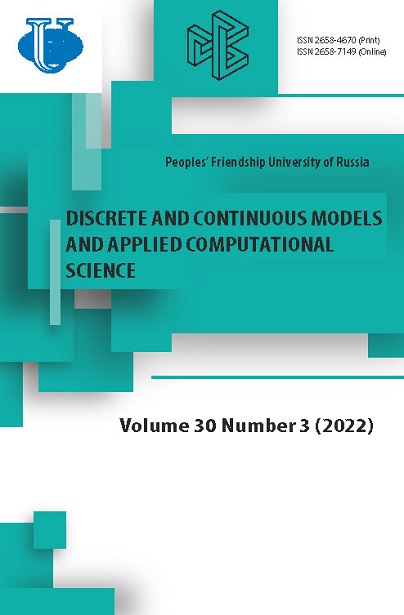Application of the method of continued boundary conditions to the solution of the problems of wave diffraction on various types of scatterers with complex structure
- Authors: Krysanov D.V.1
-
Affiliations:
- Moscow Technical University of Communications and Informatics
- Issue: Vol 30, No 3 (2022)
- Pages: 231-243
- Section: Articles
- URL: https://journals.rudn.ru/miph/article/view/32204
- DOI: https://doi.org/10.22363/2658-4670-2022-30-3-231-243
- ID: 32204
Cite item
Full Text
Abstract
The article considers the application of the method of continued boundary conditions to the two-dimensional problem of diffraction of electromagnetic waves by a dielectric body with a cross section of complex geometry and to the problem of diffraction by a Janus sphere in the form of a permeable sphere partially covered by an absolutely soft or an absolutely rigid spherical screen. The results of calculating the scattering pattern for a large set of bodies of different geometry, including fractal-like scatterers, are obtained. It is illustrated that in the case of a smooth body boundary, the algorithm based on the Fredholm equations of the 1st kind makes it possible to obtain results with greater accuracy than for equations of the 2nd kind. The correctness of the method was confirmed by verifying the implementation of the optical theorem for various bodies and by comparing with the results of calculations obtained by other methods.
Full Text
1. Introduction In the modern theory of diffraction, there is a growing need for the effective solution of increasingly complex problems, the construction of adequate mathematical models for a wide range of phenomena and processes. This, in turn, requires the development of increasingly universal methods for solving diffraction problems. In this paper, the method of continued boundary conditions (MCBC) [1] is considered. In MCBC, the surface on which the observation point is chosen, denoted byAbout the authors
Dmitry V. Krysanov
Moscow Technical University of Communications and Informatics
Author for correspondence.
Email: d.v.krysanov@mtuci.ru
ORCID iD: 0000-0001-5100-3007
postgraduate student of Department of Probability Theory and Applied Mathematics
8a, Aviamotornaya St., Moscow, 111024, Russian FederationReferences
- A. G. Kyurkchan and A. P. Anyutin, “The method of continued boundary conditions and wavelets,” Doklady Mathematics, vol. 66, no. 1, pp. 132-135, 2002.
- A. G. Kyurkchan and A. P. Anyutin, “The well-posedness of the formulation of diffraction problems reduced to Fredholm integral equations of the first kind with a smooth kernel,” Journal of Communications Technology and Electronics, vol. 51, no. 7, pp. 48-51, 2006. doi: 10.1134/S1064226906010062.
- M. I. Mishchenko, N. T. Zakharova, N. G. Khlebtsov, G. Videen, and T. Wriedt, “Comprehensive thematic T-matrix reference database: A 2015-2017 update,” Journal of Quantitative Spectroscopy and Radiative Transfer, vol. 202, pp. 240-246, 2017. doi: 10.1016/j.jqsrt.2017.08.007.
- J. Zhang, B. A. Grzybowski, and S. Granick, “Janus particle synthesis, assembly, and application,” Langmuir, vol. 33, no. 28, pp. 6964-6977, 2017. doi: 10.1021/acs.langmuir.7b01123.
- M. Lattuada and T. A. Hatton, “Synthesis, properties and applications of Janus nanoparticles,” Nano Today, vol. 6, no. 3, pp. 286-308, 2011. doi: 10.1016/j.nantod.2011.04.008.
- D. Kim, E. J. Avital, and T. Miloh, “Sound scattering and its reduction by a Janus sphere type,” Advances in Acoustics and Vibration, vol. 2014, no. 392138, 2014. doi: 10.1155/2014/392138.
- A. Gillman, “An integral equation technique for scattering problems with mixed boundary conditions,” Advances in Computational Mathematics, vol. 43, no. 2, pp. 351-364, 2017. doi: 10.1007/s10444-016-9488-6.
- S. C. Hawkins, T. Rother, and J. Wauer, “A numerical study of acoustic scattering by Janus spheres,” The Journal of the Acoustical Society of America, vol. 147, no. 6, pp. 4097-4105, 2020. doi: 10.1121/10.0001472.
- T. Rother, Sound scattering on spherical objects. Heidelberg: Springer, 2020.
- A. G. Kyurkchan and N. I. Smirnova, Mathematical modeling in diffraction theory: based on a priori information on the analytical properties of the solution. Amsterdam: Elsevier, 2015.
- D. V. Krysanov, A. G. Kyurkchan, and S. A. Manenkov, “Application of the method of continued boundary conditions to the solution of the problem of wave diffraction on scatterers of complex geometry located in homogeneous and heterogeneous media,” Optics and Spectroscopy, vol. 128, no. 4, pp. 481-489, 2020. doi: 10.1134/S0030400X20040141.
- A. G. Kyurkchan and S. A. Manenkov, “Application of different orthogonal coordinates using modified method of discrete sources for solving a problem of wave diffraction on a body of revolution,” Journal of Quantitative Spectroscopy and Radiative Transfer, vol. 113, no. 18, pp. 2368-2378, 2012. doi: 10.1016/j.jqsrt.2012.05.010.
- R. M. Crownover, Intoduction to fractals and chaos. Boston: Jones and Bartlett Publishers, 1995.
- A. G. Kyurkchan and S. A. Manenkov, “Solution of the problem of diffraction by a plane screen in a plane layered medium with the help of the method of continued boundary conditions,” Journal of Communications Technology and Electronics, vol. 65, no. 7, pp. 778-786, 2020. doi: 10.1134/S1064226920060200.
- D. V. Krysanov, A. G. Kyurkchan, and S. A. Manenkov, “Two approaches to solving the problem of diffraction on a Janus sphere,” Acoustical Physics, vol. 67, no. 2, pp. 108-119, 2021. doi: 10.1134/S1063771021020020.
- S. A. Manenkov, “A new version of the modified method of discrete sources in application to the problem of diffraction by a body of revolution,” Acoustical Physics, vol. 60, no. 2, pp. 127-133, 2014. doi: 10.1134/S1063771014010102.
Supplementary files















